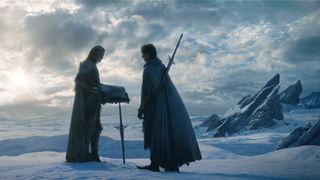If you don't know where The Rings of Power falls on the Lord of the Rings timeline – don't worry, we're here to help. The new series from Amazon does not follow Tolkien's timeline exactly and instead condenses the events of the Second Age, which spanned thousands of years. If the timeline wasn't compressed, we would be saying goodbye to a fair few human characters every other episode.
The Second Age, we should say, is the second major period in Middle-earthian history, starting with the defeat of the great evil known as Morgoth and concluding with the defeat of Sauron over three thousand years later. The events of The Hobbit and the main Lord of the Rings story take place almost three thousand years into the Third Age, and the destruction of the One Ring ushers in the Fourth Age. The Rings of Power draws on events written in Tolkien's Appendices and have never been put to screen before. In other words, we won't be meeting Sam and Frodo anytime soon. To help you get your bearings on how this all fits together, we've delved deep into the tricky timeline to round up the most important points.
When does The Rings of Power take place on the Lord of the Rings timeline?
The Rings of Power is set during Middle-earth's Second Age. This epoch spans nearly three and a half thousand years, with many of the series' events taking place around the middle of this period, circa SA 1500-1701. During this period, Celebrimbor starts the creation of the One Ring and the other rings of power after he's twisted unknowingly by Sauron – expect to see the rings in the show (as heavily hinted by the series' title).
However, those who know their Tolkein may wonder why characters who lived in a later period of the Second Age – like Elendil and Isildur – are also present. That's because the events in the show are also closer together compared to Tolkien's work as the timeline has been condensed. We know, for instance, that Isildur will cut off Sauron's hand around three and a half thousand years into the Second Age, thus bringing the Second Age to a close and starting the Third Age – we see this event take place in the prologue to Peter Jackson's movies.
Why condense the timeline? Realistically, if the show stuck to Tolkien's work exactly, only the Elven characters would be in every episode, as they're the race with the longest lifespans – hence why Galadriel and Elrond appear in both The Rings of Power and the movies, whereas other characters do not.
Speaking to Total Film earlier this year, showrunners Patrick McKay and J.D. Payne explained how a non-linear series was considered, but that would have stopped the audience from emotionally investing in the show. Payne points out how plenty of real-life historical dramas do the same thing and says their guiding principle was respect for the "spirit and feeling" of the Second Age.
The Second Age is pretty much the middle part of Middle-earth's known history. The Hobbit and The Lord of the Rings trilogy take place in the Third Age, while the First Age (which is split into two halves, the Years of the Trees and the Years of the Sun) is when the first Elves and Dwarves were awakened by the supreme deity Eru and the first Orcs were created by Morgoth – essentially, the inception of Middle-earth as we know it. The First Age ends with Morgoth's defeat.
Where did Tolkien write about the Second Age? The majority of the era's history comes from the Appendices at the end of The Return of the King, the final installment of the main Lord of the Rings trilogy. These appendices chronicle the events of the Second and Third Ages that lead up to the start of the trilogy.
Lord of the Rings: The Rings of Power is being released weekly on Prime Video every Thursday. Make sure you never miss an episode with our Lord of the Rings: The Rings of Power release schedule.

